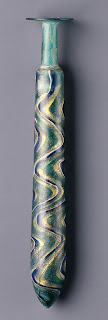The Hellenistic Era began in 323 B.C.E. with the death of Alexander the Great. His successors divided his territories and were the rulers of the Antigonid Dynasty in Macedonia, the Ptolemaic Dynasty in Egypt, and the Seleucid Empire, which consisted of Babylonia and at its peak including India, Pakistan, Mesopotamia, Persia, and much of the rest of Alexander's territories. Politically, some Greek city-states declared independence, countries broke away from the Seleucid Empire, and were ruled by individual local dynasties. The Greek language and culture spread all across Europe and Asia, influencing every facet of culture and the arts, and inspiring a massive progression in the arts never before seen. Rules and morals established during the Classical Period were all but abandoned, as artists sought to more realistically describe the human figure. Art was less preoccupied with the ideal image of the gods as artists became inspired by the more realistic aspects of human character and the psyche. Naturalism was introduced into art, the background in which an artwork was placed became just as relevant as the piece itself.. Theatrics were introduced into visual artwork, figures of a hideous Pan attempting to seduce Aphrodite, the depictions combined with the position of the body and facial expressions added a dramatic air to art, telling a story. Female nudes rose to popularity amongst sculptures, new definitions of beauty and perfection were created. In India, Greek influence is found in their artwork, where both Greek and Buddhist influences coexist in the same piece. The Hellenistic Period was a diverse era, where so many cultures collided and influenced each other, inspiring artwork, and philosophy, and the gathering of knowledge. Even after its end with the Romans rise to power in 30 B.C.E., the Hellenistic Period's artistic and cultural output remained admirable and inspirational to the Roman culture, and remains outstanding to this day.
Temple of Edfu. Built during Ptolemaic Dynasty. Egypt 237 to 257 b.c.e. source
Temple of Edfu. Built during Ptolemaic Dynasty. Egypt 237 to 257 b.c.e. source
Ganymede Jewelry, Hellenistic, 330–300 b.c.e. Greek Gold, rock crystal, emerald
source
Victory of Samothrace. 220-185 b.c.e. source
Statuette of a veiled and masked dancer, Hellenistic, 3rd–2nd century b.c.e. Greek. Bronze source
Funerary stele with a woman in childbirth, Early Hellenistic, late 4th–early 3rd century b.c.
Greek; from the Soldiers' Tomb, Ibrahimieh necropolis, Alexandria, excavated 1884
Limestone, paint . source
Funerary stele with a woman in childbirth, Early Hellenistic, late 4th–early 3rd century b.c.
Greek; from the Soldiers' Tomb, Ibrahimieh necropolis, Alexandria, excavated 1884
Limestone, paint . source
Gold-glass alabastron, 1st century b.c.e. Hellenistic. Glass. source
Statue of Eros sleeping, Hellenistic, 3rd century b.c.e.–2nd century b.c.e. Greek. Bronze. source
Papyrus fragment with lines from Homer's Odyssey, Early Hellenistic, 285–250 b.c.e. Greek, Ptolemaic. source
Head of "The Hellenistic Prince". 2nd Century bronze statue. source










No comments:
Post a Comment